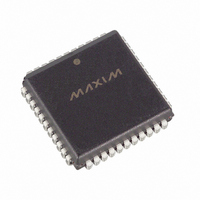DS80C310-QCG Maxim Integrated Products, DS80C310-QCG Datasheet - Page 6

DS80C310-QCG
Manufacturer Part Number
DS80C310-QCG
Description
IC MCU HI SPEED 25MHZ 44-PLCC
Manufacturer
Maxim Integrated Products
Series
80Cr
Datasheet
1.DS80C310FCG.pdf
(22 pages)
Specifications of DS80C310-QCG
Core Processor
8051
Core Size
8-Bit
Speed
25MHz
Connectivity
EBI/EMI, SIO, UART/USART
Peripherals
Brown-out Detect/Reset, POR
Number Of I /o
32
Program Memory Type
ROMless
Ram Size
256 x 8
Voltage - Supply (vcc/vdd)
4.5 V ~ 5.5 V
Oscillator Type
External
Operating Temperature
0°C ~ 70°C
Package / Case
44-LCC, 44-PLCC
Processor Series
DS80C310
Core
8051
Data Bus Width
8 bit
Program Memory Size
64 KB
Data Ram Size
64 KB
Interface Type
UART
Maximum Clock Frequency
25 MHz
Number Of Programmable I/os
32
Number Of Timers
3
Operating Supply Voltage
4.5 V to 5.5 V
Maximum Operating Temperature
+ 70 C
Mounting Style
SMD/SMT
3rd Party Development Tools
PK51, CA51, A51, ULINK2
Minimum Operating Temperature
0 C
Lead Free Status / RoHS Status
Contains lead / RoHS non-compliant
Eeprom Size
-
Program Memory Size
-
Data Converters
-
Other names
DS80C310QCG
Available stocks
Company
Part Number
Manufacturer
Quantity
Price
Company:
Part Number:
DS80C310-QCG
Manufacturer:
LINEAR
Quantity:
91
Company:
Part Number:
DS80C310-QCG
Manufacturer:
Maxim Integrated
Quantity:
10 000
Company:
Part Number:
DS80C310-QCG+
Manufacturer:
TI
Quantity:
141
Company:
Part Number:
DS80C310-QCG+
Manufacturer:
Maxim Integrated
Quantity:
10 000
Part Number:
DS80C310-QCG+
Manufacturer:
DALLAS
Quantity:
20 000
Company:
Part Number:
DS80C310-QCG+T&R
Manufacturer:
Maxim Integrated
Quantity:
10 000
Company:
Part Number:
DS80C310-QCG/T&R
Manufacturer:
Maxim Integrated
Quantity:
10 000
DS80C310
machine cycle takes 4 clocks. Thus the fastest instruction, 1 machine cycle, executes three times faster for
the same crystal frequency. Note that these are identical instructions. The majority of instructions on the
DS80C310 will see the full 3-to-1 speed improvement. Some instructions will get between 1.5 and 2.4 to
1 improvement. All instructions are faster than the original 8051.
The numerical average of all op codes gives approximately a 2.5-to-1 speed improvement. Improvement
of individual programs depends on the actual instructions used. Speed-sensitive applications would make
the most use of instructions that are three times faster. However, the sheer number of 3-to-1 improved
op codes makes dramatic speed improvements likely for any code. These architecture improvements and
0.8m CMOS produce a peak instruction cycle in 160ns (6.25MIPS). The dual data pointer feature also
allows the user to eliminate wasted instructions when moving blocks of memory.
INSTRUCTION SET SUMMARY
All instructions in the DS80C310 perform the same functions as their 8051 counterparts. Their effect on
bits, flags, and other status functions is identical. However, the timing of each instruction is different.
This applies both in absolute and relative number of clocks.
For absolute timing of real-time events, the timing of software loops can be calculated using a table in the
High-Speed Microcontroller User’s Guide. However, counter/timers default to run at the older 12 clocks
per increment. In this way, timer-based events occur at the standard intervals with software executing at
higher speed. Timers optionally can run at 4 clocks per increment to take advantage of faster processor
operation.
The relative time of two instructions might be different in the new architecture than it was previously. For
example, in the original architecture the “MOVX A, @ DPTR” instruction and the “MOV direct, direct”
instruction used 2 machine cycles or 24 oscillator cycles. Therefore, they required the same amount of
time. In the DS80C310, the MOVX instruction takes as little as 2 machine cycles or 8 oscillator cycles
but the “MOV direct, direct” uses 3 machine cycles or 12 oscillator cycles. While both are faster than
their original counterparts, they now have different execution times. This is because the DS80C310
usually uses 1 instruction cycle for each instruction byte. The user concerned with precise program timing
should examine the timing of each instruction for familiarity with the changes. Note that a machine cycle
now requires just 4 clocks, and provides one ALE pulse per cycle. Many instructions require only 1 cycle,
but some require 5. In the original architecture, all were 1 or 2 cycles except for MUL and DIV. Refer to
the High-Speed Microcontroller User’s Guide for details and individual instruction timing.
6 of 22
















